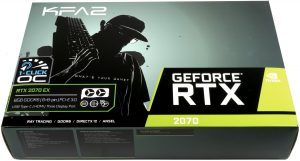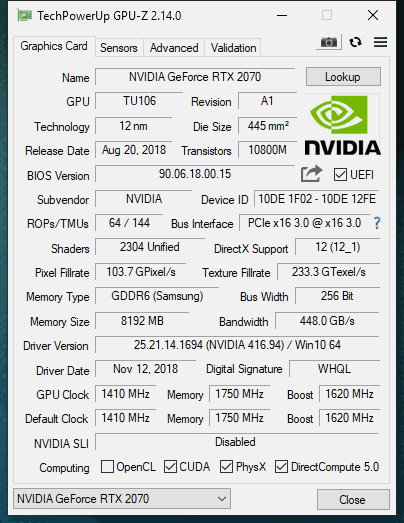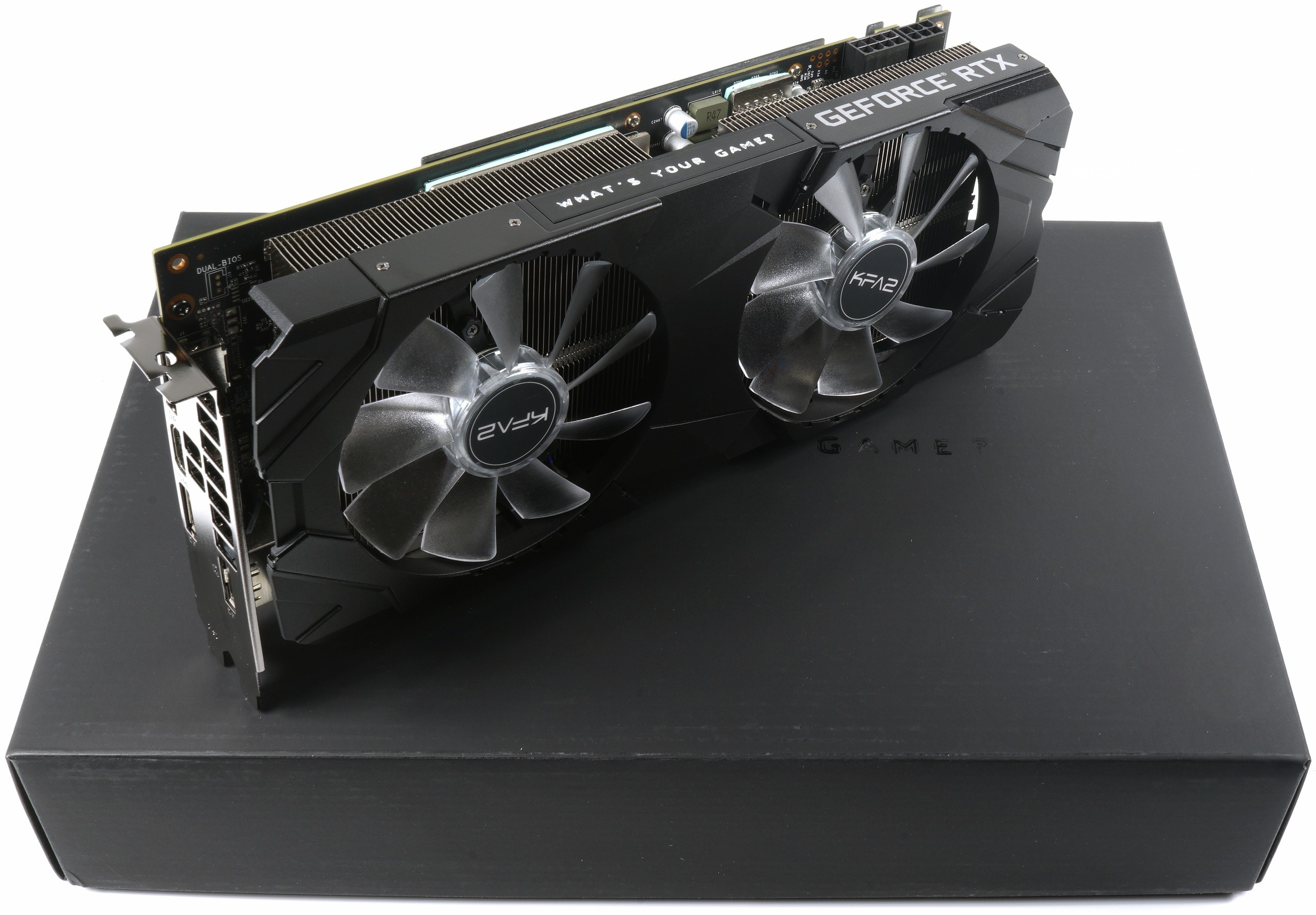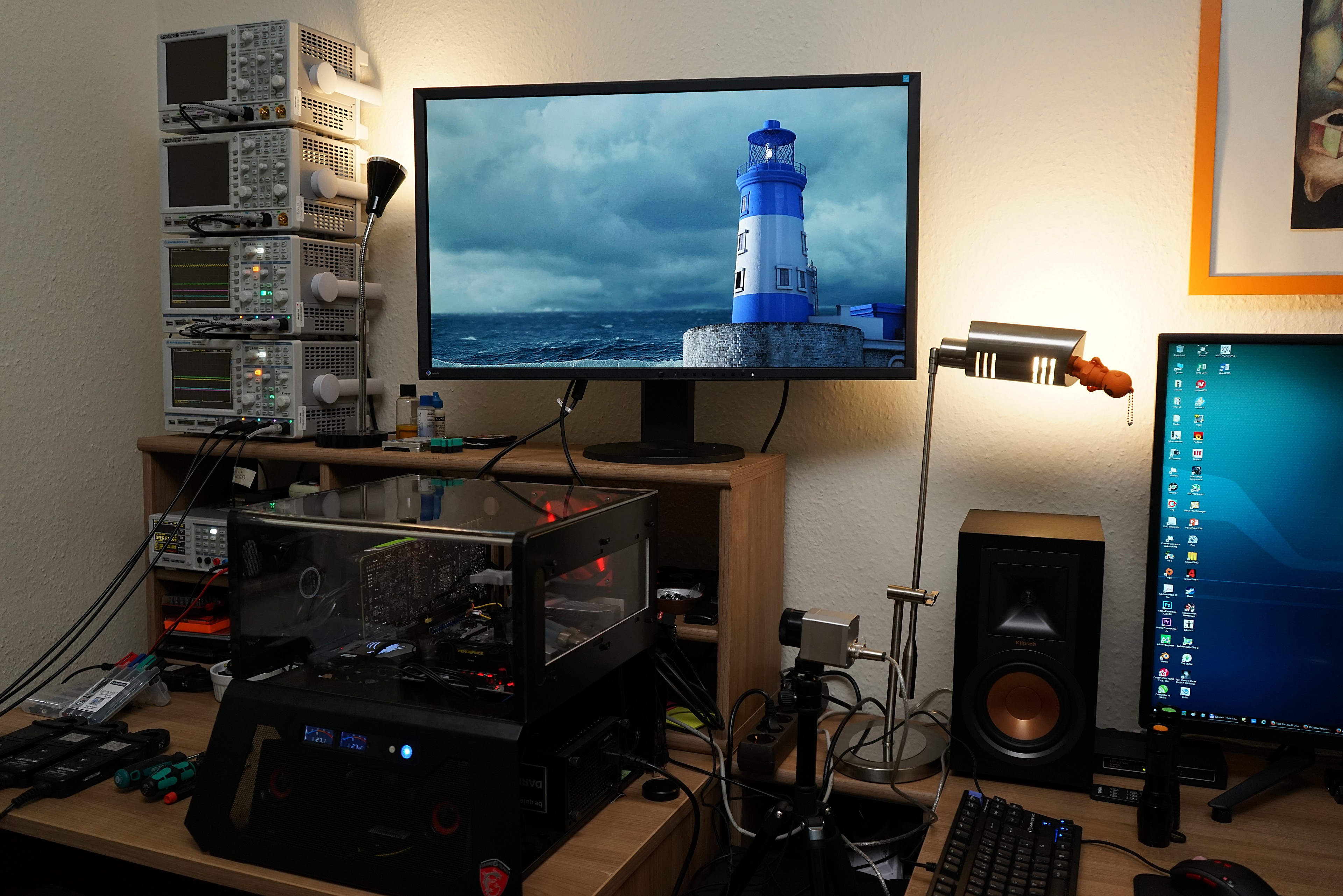 The opposite of expensive does not always have to be cheap. In fact, it would also be inexpensive. This is exactly what KFA2 must have thought when the GeForce RTX 2070 EX was designed. Many things were taken over here from the larger KFA2 cards and also the cooler has a decent portiönchen hip bacon, so that nothing burns.
The opposite of expensive does not always have to be cheap. In fact, it would also be inexpensive. This is exactly what KFA2 must have thought when the GeForce RTX 2070 EX was designed. Many things were taken over here from the larger KFA2 cards and also the cooler has a decent portiönchen hip bacon, so that nothing burns.
But they have also focused on hitting the price point (and probably the nerves of the buyers) as optimally as possible. The EIA of 499 euros is almost a battle announcement, because the cards of some competitors are up to 100 euros more expensive. Compromise? Well, it's not an A-chip. But we will see in a moment that this does not have to be a shortcoming if only the cooler is good enough to win Boost. And the 1-click-boost via software is also available.
Speaking of coolers… At 1073 grams, the card has been prescribed a light diet, but it is not a real ultra-light aviator. And that's a good thing, because somewhere the cooling surface has to come. The card is 28.5 cm long between the outer edge of the slot panel and the end of the radiator cover, measures 12 cm from the top edge of the slot panel to the top edge of the graphics card housing and is 4.7 cm thick. In addition, there is another 0.5 cm for the blackened backplate.
The cover is made of black, semi-gloss plastic with applied black light metal applications and of course there are RGB-lit rotor blades and the usual "GeForce RTX" lettering in full color. A bit of fun has to be easy and if you like to tap in the dark, you can also drag the roller blind down to night mode via software. The two 9.7 cm fans, each with 9 rotor blades, sit in a 10 cm opening.
The video outputs are the minimum assembly for the maximum controllable 4 output devices from Nvidia: once HDMI 2.0 meets 3x DisplayPort 1.4. But it's enough. KFA2 delivers the card with two external ATX power supply connectors (8-pin + 6-pin). But more the screenshot of GPU-Z gives us a first impression:

Technical data and comparison maps
At the end of this introduction, the maps of the new generation and those of the old generation in direct tabular comparison:
| GeForce RTX 2070 FE |
KFA2 RTX 2070 EX | GeForce GTX 1070 FE |
GeForce RTX 2080 FE | |
| Architecture (GPU) |
Turing (TU106) | Turing (TU106) | Pascal (GP104) | Turing (TU104) |
| CUDA Cores |
2304 | 2304 | 1920 | 2944 |
| Tensor Cores |
288 | 288 | N/A | 368 |
| RT Cores |
36 | 36 | N/A | 48 |
| Texture Units |
144 | 114 | 120 | 184 |
| Base Clock Rate |
1410 MHz | 1410 MHz | 1506 MHz | 1515 MHz |
| GPU Boost Rate |
1710 MHz | 1620 MHz | 1683 MHz | 1800 MHz |
| Storage expansion |
8GB GDDR6 | 8GB GDDR6 | 8GB GDDR5 | 8GB GDDR6 |
| Storage bus |
256-bit | 256-bit | 256-bit | 256-bit |
| Bandwidth |
448 GB/s | 448 GB/s | 256 GB/s | 448 GB/s |
| Rops |
64 | 64 | 64 | 64 |
| L2 Cache |
4MB | 4MB | 2MB | 4 MB |
| Tdp |
185W | 185 W | 150w | 225 W |
| Transistors |
10.8 billion | 10.8 billion |
7.2 billion | 13.6 billion |
| The size |
445 mm2 | 445 mm2 | 314 mm2 | 545 mm2 |
| Sli |
No | No | Yes (MIO) | Yes (1x NVLink) |
Test system and measurement methods
We have already described the new test system and the methodology in detail in the basic article "How We Test Graphics Cards, as of February 2017" and therefore refer to this detailed basis for simplicity. Description. So if you want to read everything again, you are welcome to do so.
If you are interested, the summary in table form quickly provides a brief overview:
| Test systems and measuring rooms | |
|---|---|
| Hardware: |
Intel Core i7-8700K x 5 GHz MSI Z370 Gaming Pro Carbon AC 16GB KFA2 DDR4 4000 Hall of Fame 1x 1 TByte Toshiba OCZ RD400 (M.2, System SSD) 2x 960 GByte Toshiba OCZ TR150 (Storage, Images) Be Quiet Dark Power Pro 11, 850-watt power supply |
| Cooling: |
Alphacool Ice Block XPX 5x Be Quiet! Silent Wings 3 PWM (Closed Case Simulation) Thermal Grizzly Kryonaut (for cooler change) |
| Housing: |
Lian Li PC-T70 with expansion kit and modifications Modes: Open Benchtable, Closed Case |
| Monitor: | Eizo EV3237-BK |
| Power consumption: |
non-contact DC measurement on the PCIe slot (Riser-Card) non-contact DC measurement on the external PCIe power supply Direct voltage measurement on the respective feeders and on the power supply 2x Rohde & Schwarz HMO 3054, 500 MHz multi-channel oscillograph with memory function 4x Rohde & Schwarz HZO50, current togor adapter (1 mA to 30 A, 100 KHz, DC) 4x Rohde & Schwarz HZ355, touch divider (10:1, 500 MHz) 1x Rohde & Schwarz HMC 8012, digital multimeter with storage function |
| Thermography: |
Optris PI640, infrared camera PI Connect evaluation software with profiles |
| Acoustics: |
NTI Audio M2211 (with calibration file) Steinberg UR12 (with phantom power for the microphones) Creative X7, Smaart v.7 own low-reflection measuring room, 3.5 x 1.8 x 2.2 m (LxTxH) Axial measurements, perpendicular to the center of the sound source(s), measuring distance 50 cm Noise in dBA (Slow) as RTA measurement Frequency spectrum as a graph |
| Operating system | Windows 10 Pro (1809, all updates) |









































Kommentieren